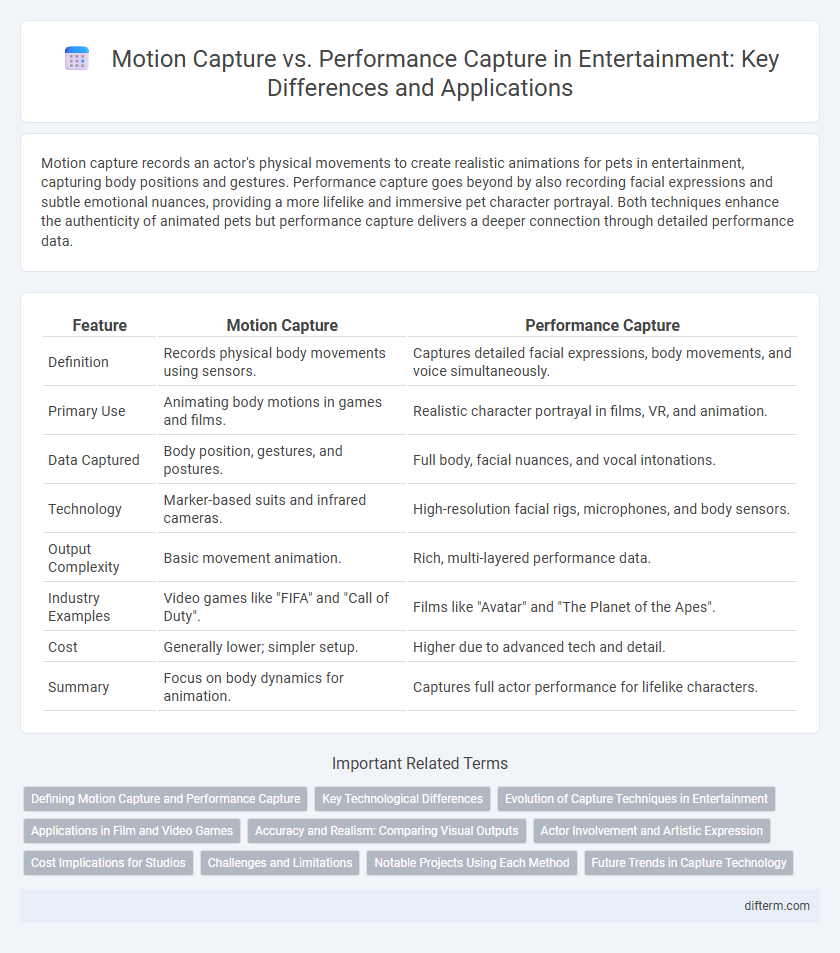Motion capture records an actor's physical movements to create realistic animations for pets in entertainment, capturing body positions and gestures. Performance capture goes beyond by also recording facial expressions and subtle emotional nuances, providing a more lifelike and immersive pet character portrayal. Both techniques enhance the authenticity of animated pets but performance capture delivers a deeper connection through detailed performance data.
Table of Comparison
| Feature | Motion Capture | Performance Capture |
|---|---|---|
| Definition | Records physical body movements using sensors. | Captures detailed facial expressions, body movements, and voice simultaneously. |
| Primary Use | Animating body motions in games and films. | Realistic character portrayal in films, VR, and animation. |
| Data Captured | Body position, gestures, and postures. | Full body, facial nuances, and vocal intonations. |
| Technology | Marker-based suits and infrared cameras. | High-resolution facial rigs, microphones, and body sensors. |
| Output Complexity | Basic movement animation. | Rich, multi-layered performance data. |
| Industry Examples | Video games like "FIFA" and "Call of Duty". | Films like "Avatar" and "The Planet of the Apes". |
| Cost | Generally lower; simpler setup. | Higher due to advanced tech and detail. |
| Summary | Focus on body dynamics for animation. | Captures full actor performance for lifelike characters. |
Defining Motion Capture and Performance Capture
Motion capture records an actor's physical movements using sensors or markers to create digital animations, primarily capturing body motion. Performance capture expands on this by also tracking facial expressions and finger movements to preserve subtle human emotions and nuances for more lifelike digital characters. Both technologies are essential in video games, film, and virtual reality to enhance realistic character animation with varying levels of detail and complexity.
Key Technological Differences
Motion capture records an actor's physical movements using sensors or markers to translate body actions into digital data, while performance capture integrates facial expressions and subtle body language to provide a more comprehensive digital portrayal. Performance capture uses advanced camera systems and facial rigs to capture intricate emotion details, beyond just positional data. This technology enables filmmakers to create highly realistic and emotionally engaging characters in video games, films, and virtual reality environments.
Evolution of Capture Techniques in Entertainment
Motion capture initially recorded basic body movements using optical markers, revolutionizing character animation in video games and films. Performance capture advances this technology by integrating facial expressions and finger movements, delivering nuanced performances crucial for immersive storytelling. The evolution from motion to performance capture reflects the entertainment industry's pursuit of authentic, emotionally resonant digital characters.
Applications in Film and Video Games
Motion capture tracks an actor's body movements to animate digital characters in film and video games, while performance capture includes detailed facial expressions and subtle emotional nuances for more lifelike portrayals. In blockbuster movies like "Avatar" and video games such as "The Last of Us," performance capture delivers immersive character performances that enhance storytelling and player engagement. This technology bridges the gap between live acting and digital animation, revolutionizing visual effects and interactive entertainment.
Accuracy and Realism: Comparing Visual Outputs
Motion capture captures basic body movements using sensors, delivering accurate positional data but often lacks fine facial expressions and subtle gestures. Performance capture enhances this by integrating detailed facial and hand motion tracking, producing more realistic and emotionally expressive visual outputs. The increased data fidelity in performance capture leads to higher accuracy in depicting nuanced performances essential for immersive entertainment experiences.
Actor Involvement and Artistic Expression
Motion capture captures an actor's physical movements using sensors to translate body actions into digital animations, emphasizing precise gesture replication. Performance capture extends this by recording facial expressions and voice simultaneously, enabling deeper Actor involvement and richer artistic expression. This holistic approach allows actors to convey nuanced emotions, resulting in more authentic and emotionally engaging digital characters.
Cost Implications for Studios
Motion capture generally incurs lower costs than performance capture due to simpler equipment and fewer stages in production. Performance capture demands advanced facial scanning technology and synchronized audio recording, increasing expenses significantly. Studios must balance budget constraints against the enhanced realism and nuanced actor performances that performance capture delivers.
Challenges and Limitations
Motion capture faces challenges in accurately capturing subtle facial expressions and finger movements, often requiring additional data layers to enhance realism. Performance capture improves on these limitations by integrating full-body and facial expressions simultaneously but demands advanced technology and higher costs, making it less accessible for smaller productions. Both techniques struggle with occlusion issues and motion blur, requiring sophisticated software to interpret incomplete or noisy data effectively.
Notable Projects Using Each Method
Notable projects using motion capture include the "Avatar" series by James Cameron, where realistic character movements were created through extensive sensor-based tracking. Performance capture, which integrates facial expressions and body movements, was employed in "The Lord of the Rings" trilogy for Gollum, showcasing enhanced emotional depth. Both techniques have revolutionized visual storytelling by enabling lifelike digital characters in blockbuster films and video games.
Future Trends in Capture Technology
Performance capture is evolving with ultra-high-resolution sensors and AI-driven real-time rendering, enabling more precise facial expressions and body movements that enhance immersive storytelling. Emerging neural network algorithms improve data processing speed and accuracy, reducing post-production time and costs. Hybrid capture systems combining optical and inertial sensors promise seamless integration of physical and virtual performances, shaping the next era of entertainment technology.
motion capture vs performance capture Infographic

 difterm.com
difterm.com